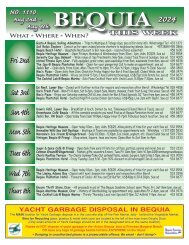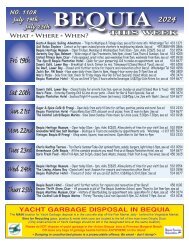Caribbean Compass Yachting Magazine - April 2021
Welcome to Caribbean Compass, the most widely-read boating publication in the Caribbean! THE MOST NEWS YOU CAN USE - feature articles on cruising destinations, regattas, environment, events...
Welcome to Caribbean Compass, the most widely-read boating publication in the Caribbean! THE MOST NEWS YOU CAN USE - feature articles on cruising destinations, regattas, environment, events...
You also want an ePaper? Increase the reach of your titles
YUMPU automatically turns print PDFs into web optimized ePapers that Google loves.
APRIL <strong>2021</strong> CARIBBEAN COMPASS PAGE 10<br />
CARIBBEAN<br />
ECO-NEWS<br />
Major step toward Blue Economy<br />
for five OECS states<br />
As Toni Allen explained in a recent article at https://<br />
technewstt.com/blue-economy, <strong>Caribbean</strong> nations are<br />
still struggling to find their place in an increasingly<br />
global world. One in five <strong>Caribbean</strong> citizens remain<br />
below the poverty line, growth is almost three percent<br />
lower than the global average, and the region is the<br />
second most at risk from environmental hazards due<br />
to climate change.<br />
Anse Cochon. St. Lucia is one of the five OECS<br />
member states that have begun validating Coastal<br />
and Marine Spatial Plans.<br />
The impact from Covid-19 has made progress more<br />
complex. Some business sectors have surged during the<br />
pandemic. These include e-commerce and online<br />
learning, as well as business and finance sites. But the<br />
<strong>Caribbean</strong> nations have not noticeably benefitted from<br />
these trends.<br />
The challenges are significant but there is a<br />
solution. It lies in <strong>Caribbean</strong> nations nurturing a<br />
“Blue Economy.” This could have an impact far<br />
beyond local governance and encourage international<br />
investors to boost direct investment. There are a<br />
number of definitions for the Blue Economy, but they<br />
all follow a key theme: the sustainable use of ocean<br />
resources to improve economic growth while<br />
protecting the oceans themselves.<br />
In a step toward transitioning to a Blue Economy,<br />
Dominica, Grenada, St. Lucia, St. Kitts & Nevis, and<br />
St. Vincent & the Grenadines have begun the process<br />
of validating Coastal and Marine Spatial Plans (CMSP)<br />
prepared under the <strong>Caribbean</strong> Regional Oceanscape<br />
Project (CROP).<br />
Transitioning from Small Island Developing States to<br />
Large Ocean States through sustainable use of ocean<br />
resources is a major goal of the OECS. To enable<br />
fulfillment of this goal, the development of Coastal and<br />
Marine Spatial Plans forms a major component of<br />
CROP (https://oecs.org/en/crop), which is currently<br />
being implemented by the OECS Commission on<br />
behalf of Member States.<br />
A Validation Forum was held via the OECS Virtual<br />
Convention Centre on February 26th.<br />
During the Validation Forum, Dillon Consulting<br />
presented summaries of the revised draft CMSPs for<br />
the five Member States, which were prepared from<br />
consultations with key stakeholders, building on<br />
existing work in coastal and marine planning. The<br />
Forum marked the culmination of a two-year process<br />
of stakeholder engagement. The presentation included<br />
Coastal Zoning Maps (models) depicting conservation,<br />
transportation, tourism and recreation, fishing, and<br />
industrial zones. The consultants also presented a<br />
range of Blue Economy projects for the Member States<br />
under the following areas: climate resilience,<br />
environmental protection, economic growth, good<br />
governance, and equitable development. Proposed<br />
projects include initiatives in aquaculture, mariculture,<br />
fisheries, renewable energy exploration, waterfront<br />
development, village tourism, coastal replanting,<br />
beach nourishment, and conversion of fish waste to<br />
fertilizer. Also proposed was the establishment of a<br />
maritime training facility, as well as a Blue Economy<br />
incubator and accelerator programme.<br />
The validation of the draft CMSPs marks a critical<br />
stage in the region’s transition to a Blue Economy.<br />
These plans define an enabling framework that sets<br />
the stage for blue growth investments and offer a<br />
15-year timeframe to support the transition towards a<br />
Blue Economy through sustainable and equitable use<br />
of coastal and marine space, protecting coastal and<br />
marine ecosystems, and managing land-water<br />
interactions. Guided by an evidence-based Island<br />
Systems Management, the plans serve as national<br />
blue economy roadmaps with interventions and<br />
investments aimed at achieving mutually reinforcing<br />
outcomes of good governance, economic growth,<br />
equitable development, environmental protection, and<br />
climate resilience.<br />
Visit https://pressroom.oecs.org/oecs-memberstates-take-a-major-step-in-transitioning-to-a-blueeconomy<br />
for more information.<br />
Detecting invasive mammals on offshore<br />
Grenadine islands<br />
Juliana Coffey reports: Throughout 2019-2020<br />
Environmental Protection in the <strong>Caribbean</strong> (EPIC) has<br />
focused efforts to document the presence of invasive<br />
mammal species on offshore Grenadine islands. The<br />
uninhabited islands of the Grenadines are globally<br />
important for nesting seabirds and host regionally<br />
endemic and endangered reptile species, such as sea<br />
turtles — all of which are known to be especially<br />
vulnerable to invasive mammal species where they occur.<br />
Invasive species, whether purposefully or<br />
accidentally introduced to areas beyond their native<br />
ranges, can become harmful to the local environment,<br />
oftentimes with negative consequences for local<br />
economies and even human health. Their role in<br />
extirpations and extinctions of native species is well<br />
documented worldwide.<br />
EPIC and Ocean Spirits Inc conducted land-based<br />
surveys focused on detecting rodents with baited<br />
tracking tunnels and trail cameras.<br />
CHRIS DOYLE KATE CHARLES<br />
Introduction of non-native mammal species to the<br />
<strong>Caribbean</strong> region coincided with arrivals of human<br />
inhabitants. Domestic animals were often brought<br />
along as a source of nutrition and companionship,<br />
while others, such as rodents, were unintentionally<br />
introduced. One of the best-known invasive mammal<br />
species in the region is the mongoose, existing on<br />
many <strong>Caribbean</strong> islands, including mainland Grenada<br />
and St. Vincent. While mongooses were purposely<br />
introduced to control burgeoning rodent populations,<br />
they have been especially detrimental to native reptile<br />
and bird populations throughout the region, including<br />
the critically endangered Grenada Dove.<br />
Introduced mammals known to exist on the<br />
uninhabited islands of the Grenadines consist of both<br />
grazing and predatory animals, including goats,<br />
sheep, cows, dogs, cats, rats, mice and opossum.<br />
While predatory animals can directly injure or kill<br />
native species, livestock can trample nests, cause<br />
disturbance and significantly reduce plant cover,<br />
contributing to erosion and smothering of adjacent<br />
coral reef and fisheries habitat.<br />
Between 2019-2020, the Grenadines Seabird<br />
Guardians, a citizen scientist group, visited 37 offshore<br />
islands in Grenada and SVG, conducting land and<br />
boat-based observations of wildlife and documenting<br />
the presence of non-native mammals. The most<br />
frequently detected non-native mammals were feral<br />
goats, with populations confirmed on at least 16 of the<br />
islands visited. Other species observed included sheep,<br />
cats and dogs.<br />
In December 2020, EPIC and Ocean Spirits Inc<br />
joined efforts to conduct land-based surveys focused<br />
on detecting rodents with baited tracking tunnels and<br />
trail cameras. These investigations targeted seven<br />
offshore islands in the Grenada Grenadines, with field<br />
support from Dr. Kenrith Carter (Grenada), Kendon<br />
James (Grenada), Vaughn Thomas (Carriacou), and<br />
Rene Isaacs (Carriacou). These surveys contributed to<br />
the current knowledgebase of rodents on at least eight<br />
uninhabited islands, with suspected presence at<br />
additional sites. Rats in particular are known for their<br />
strong swimming abilities between islands, and<br />
although they were not detected at some sites, the lack<br />
of detection is not proof of their absence.<br />
Despite legislation prohibiting the release of<br />
domestic animals on Crown Land and in protected<br />
areas in Grenada and SVG, research has shown that<br />
they regularly occur in such areas with minimal to no<br />
intervention. Feral goat populations are prevalent in<br />
Wildlife Reserves and International Bird Areas, and<br />
occur on islands in the Tobago Cays Marine Park, the<br />
Sandy Island Oyster Bed Marine Protected Area, and<br />
in several proposed marine protected areas. While<br />
landholders may graze animals on privately owned<br />
islands outside of protected areas, their negative<br />
effects on flora and fauna at these sites remain<br />
uninvestigated and unregulated.<br />
Efforts to remove or manage harmful invasive<br />
mammal species in other areas have proven to<br />
recover native biodiversity; however, without outreach<br />
and education on their negative effects, the likelihood<br />
of reintroductions to Grenadines islands is high. A<br />
working group of local stakeholders has been<br />
established to address the impacts of invasive<br />
mammals and other issues as part of the Grenadines<br />
Seabird Conservation Management Plan. With the<br />
support of communities and management agencies,<br />
reducing the negative impacts of invasive mammals<br />
is feasible.<br />
Funding for this research was provided by the US<br />
Agency for International Development, US Fish and<br />
Wildlife Service and the Specially Protected Areas<br />
and Wildlife.<br />
Visit www.epicislands.org for more information.<br />
Tobago Cays staff trained<br />
in biophysical monitoring<br />
The Biophysical Monitoring Training Course for<br />
staff at St. Vincent & the Grenadines’ Tobago Cays<br />
Marine Park was completed in December 2020; six<br />
staff members are now certified and can conduct<br />
routine Biophysical Monitoring at the park. The<br />
Biophysical Monitoring Training Program will provide<br />
the park with the institutional capacity to determine<br />
the changes in abundance, size, species composition,<br />
and biomass of ecologically and economically<br />
important species.<br />
Participants conducted in-water monitoring for<br />
seagrass and sea urchins at two of the permanent<br />
monitoring sites and monitored for Queen Conch at<br />
three of the permanent monitoring sites within the<br />
TCMP. The water quality training covered areas<br />
such as completing data sheets, labeling sample<br />
bottles, collecting water samples and collecting<br />
in-situ monitoring parameters (temperature,<br />
turbidity). Water quality analyses for parameters<br />
(dissolved oxygen, pH, nitrates, phosphates and<br />
coliform bacteria) were also done. Data entry and<br />
analysis: this component of the program was<br />
designed to allow for the development of monitoring<br />
reports that would follow all monitoring activities<br />
and help to facilitate the adaptive management<br />
process of the TCMP.<br />
—Continued on next page

















